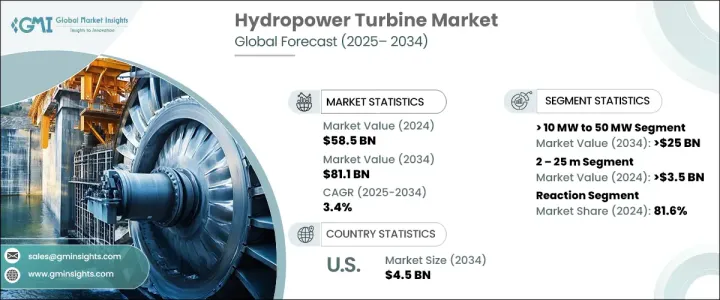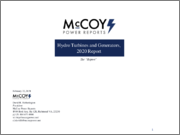
|
시장보고서
상품코드
1716496
수력 발전 터빈 시장 기회, 성장 촉진 요인, 산업 동향 분석, 예측(2025-2034년)Hydropower Turbine Market Opportunity, Growth Drivers, Industry Trend Analysis, and Forecast 2025 - 2034 |
||||||
세계 수력 발전 터빈 시장은 2024년에 585억 달러로 평가되었고, 2025년부터 2034년까지 연평균 복합 성장률(CAGR) 3.4%로 성장할 것으로 예측됩니다.
신뢰성이 높고 지속가능한 전력원에 대한 세계 수요 증가가 이 확대에 박차를 가하고 있습니다. 출하량의 감소가 중시되고, 재생가능에너지의 도입을 촉진하는 정부의 정책도 함께 시장은 더욱 확대되고 있습니다.

또한 터빈 기술의 진보로 운영 효율성이 크게 향상되고 유지 보수 비용이 절감되고 수력 발전 프로젝트의 전반적인 지속가능성이 높아지고 있습니다. 한편, 증가하는 에너지 수요를 충족시키기 위해 수력 발전소의 개량에 많은 투자를 실시했습니다.
| 시장 범위 | |
|---|---|
| 시작 연도 | 2024년 |
| 예측 연도 | 2025-2034년 |
| 시작 금액 | 585억 달러 |
| 예측 금액 | 811억 달러 |
| CAGR | 3.4% |
시장은 터빈 용량으로 구분되며 1MW 이하, 1MW-10MW, 10MW-50MW, 50MW 초과가 주요 카테고리입니다. MW의 부문은 2034년까지 250억 달러를 생산할 것으로 예측됩니다. 정화하고 안정된 전력을 공급함으로써 대규모 에너지 수요를 충족시키는데 필수적인 존재가 되고 있습니다.
또 다른 주요 부문은 터빈 유형을 기반으로하며 임펄스 터빈과 반응 터빈으로 분류됩니다. 2024년에는 반응 터빈 부문이 시장 점유율의 81.6%를 차지했습니다. 그들의 친환경 디자인은 생태계에 미치는 영향을 최소화하고 지속가능한 에너지 생성을 지원합니다.
미국의 수력발전 터빈 시장은 2024년에 44억 달러로 평가되었습니다. 재생 에너지 인프라를 확장하고 강 외 수력 발전 프로젝트를 촉진하기 위한 정부의 인센티브가 이 성장을 뒷받침하고 있습니다. 또한, 관민간의 협력적인 대처가 기술 혁신을 촉진해, 수력 발전 시스템의 배치를 강화하고 있습니다.
목차
제1장 조사 방법과 조사 범위
제2장 주요 요약
제3장 업계 인사이트
- 생태계 분석
- 규제 상황
- 업계에 미치는 영향요인
- 성장 촉진요인
- 업계의 잠재적 위험 및 과제
- 성장 가능성 분석
- Porter's Five Forces 분석
- PESTEL 분석
제4장 경쟁 구도
- 소개
- 전략적 전망
- 혁신과 지속가능성의 전망
제5장 시장 규모와 예측 : 용량별, 2021년-2034년
- 주요 동향
- 1 MW 이하
- 1 MW- 10 MW
- 10 MW- 50 MW
- 50 MW 이상
제6장 시장 규모와 예측 : 헤드별, 2021년-2034년
- 주요 동향
- 2-25 m
- 25-70 m
- 70m초
제7장 시장 규모와 예측 : 제품별, 2021년-2034년
- 주요 동향
- 임펄스
- 반응
제8장 시장 규모와 예측 : 지역별, 2021년-2034년
- 주요 동향
- 북미
- 미국
- 캐나다
- 멕시코
- 유럽
- 프랑스
- 오스트리아
- 노르웨이
- 러시아
- 이탈리아
- 스위스
- 튀르키예
- 스웨덴
- 아시아태평양
- 중국
- 인도
- 베트남
- 부탄
- 인도네시아
- 네팔
- 스리랑카
- 중동 및 아프리카
- 에티오피아
- 이란
- 이스라엘
- 나이지리아
- 잠비아
- 라틴아메리카
- 브라질
- 페루
- 아르헨티나
제9장 기업 프로파일
- ANDRITZ
- B fouress
- Dobriyal Brothers
- GE Vernova
- Gilkes
- GUGLER Water Turbines
- Jyoti
- Litostroj Power
- Mitsubishi Heavy Industries
- Natel Energy
- Pentaflo Hydro
- Siemens Energy
- Toshiba
- Turbiwatt
- Voith
The Global Hydropower Turbine Market generated USD 58.5 billion in 2024 and is projected to grow at a CAGR of 3.4% between 2025 and 2034. The growing global demand for reliable and sustainable electricity sources is fueling this expansion. Hydropower, known for its ability to generate clean energy on a large scale, is becoming a preferred solution to meet the rising electricity needs of both developing and developed nations. The increasing emphasis on reducing carbon emissions, coupled with government policies promoting renewable energy adoption, is further strengthening the market. Hydropower offers unparalleled reliability and flexibility, making it an ideal complement to other renewable sources like wind and solar energy.

Additionally, advancements in turbine technology are significantly improving operational efficiency, reducing maintenance costs, and enhancing the overall sustainability of hydropower projects. This, along with the modernization of aging infrastructure, is propelling the market forward. Governments and private entities are investing heavily in upgrading hydropower plants to meet growing energy demands while ensuring minimal environmental impact. The increasing adoption of small and micro hydropower systems in rural and off-grid regions is also contributing to market growth, offering decentralized power solutions in areas with limited access to traditional power grids.
| Market Scope | |
|---|---|
| Start Year | 2024 |
| Forecast Year | 2025-2034 |
| Start Value | $58.5 Billion |
| Forecast Value | $81.1 Billion |
| CAGR | 3.4% |
The market is segmented based on turbine capacity, with key categories including <= 1 MW, > 1 MW to 10 MW, > 10 MW to 50 MW, and > 50 MW. The > 10 MW to 50 MW segment is expected to generate USD 25 billion by 2034. These turbines are preferred for their ability to provide large-scale power output, making them ideal for high-demand applications in densely populated urban areas and industrial zones. Their role in grid stabilization and consistent power delivery under varying load conditions makes them indispensable for meeting large-scale energy requirements. This segment is experiencing strong growth as utilities and governments focus on enhancing grid reliability and supporting industrial expansion.
Another key segment is based on turbine type, categorized into impulse and reaction turbines. In 2024, the reaction turbine segment accounted for 81.6% of the market share. Reaction turbines are highly efficient for medium to large-scale projects, especially in regions with variable water flow rates. Their eco-friendly design minimizes ecological disruption and supports sustainable energy generation. As governments and utilities seek to replace older, less efficient turbines with advanced models, the demand for reaction turbines is poised to grow. Their ability to handle higher water pressures and adapt to different operating conditions makes them a preferred choice for hydropower developers.
The U.S. Hydropower Turbine Market was valued at USD 4.4 billion in 2024. The country is witnessing an increasing focus on distributed energy resources and the development of small and micro hydropower projects. Government incentives aimed at expanding renewable energy infrastructure and promoting off-river hydropower projects are driving this growth. Additionally, collaborative efforts between public and private sectors are fostering technological innovation and enhancing the deployment of hydropower systems. These initiatives are positioning the U.S. as a key player in advancing hydropower technology and contributing significantly to the global market.
Table of Contents
Chapter 1 Methodology & Scope
- 1.1 Market scope & definitions
- 1.2 Market estimates & forecast parameters
- 1.3 Forecast calculation
- 1.4 Data sources
- 1.4.1 Primary
- 1.4.2 Secondary
- 1.4.2.1 Paid
- 1.4.2.2 Public
Chapter 2 Executive Summary
- 2.1 Industry synopsis, 2021 - 2034
Chapter 3 Industry Insights
- 3.1 Industry ecosystem analysis
- 3.2 Regulatory landscape
- 3.3 Industry impact forces
- 3.3.1 Growth drivers
- 3.3.2 Industry pitfalls & challenges
- 3.4 Growth potential analysis
- 3.5 Porter's analysis
- 3.5.1 Bargaining power of suppliers
- 3.5.2 Bargaining power of buyers
- 3.5.3 Threat of new entrants
- 3.5.4 Threat of substitutes
- 3.6 PESTEL analysis
Chapter 4 Competitive Landscape, 2024
- 4.1 Introduction
- 4.2 Strategic outlook
- 4.3 Innovation & sustainability landscape
Chapter 5 Market Size and Forecast, By Capacity, 2021 - 2034 (MW & USD Million)
- 5.1 Key trends
- 5.2 ≤ 1 MW
- 5.3 > 1 MW to 10 MW
- 5.4 > 10 MW to 50 MW
- 5.5 > 50 MW
Chapter 6 Market Size and Forecast, By Head, 2021 - 2034 (MW & USD Million)
- 6.1 Key trends
- 6.2 2 – 25 m
- 6.3 > 25 – 70 m
- 6.4 > 70 m
Chapter 7 Market Size and Forecast, By Product, 2021 - 2034 (MW & USD Million)
- 7.1 Key trends
- 7.2 Impulse
- 7.3 Reaction
Chapter 8 Market Size and Forecast, By Region, 2021 - 2034 (MW & USD Million)
- 8.1 Key trends
- 8.2 North America
- 8.2.1 U.S.
- 8.2.2 Canada
- 8.2.3 Mexico
- 8.3 Europe
- 8.3.1 France
- 8.3.2 Austria
- 8.3.3 Norway
- 8.3.4 Russia
- 8.3.5 Italy
- 8.3.6 Switzerland
- 8.3.7 Turkey
- 8.3.8 Sweden
- 8.4 Asia Pacific
- 8.4.1 China
- 8.4.2 India
- 8.4.3 Vietnam
- 8.4.4 Bhutan
- 8.4.5 Indonesia
- 8.4.6 Nepal
- 8.4.7 Sri Lanka
- 8.5 Middle East & Africa
- 8.5.1 Ethiopia
- 8.5.2 Iran
- 8.5.3 Israel
- 8.5.4 Nigeria
- 8.5.5 Zambia
- 8.6 Latin America
- 8.6.1 Brazil
- 8.6.2 Peru
- 8.6.3 Argentina
Chapter 9 Company Profiles
- 9.1 ANDRITZ
- 9.2 B fouress
- 9.3 Dobriyal Brothers
- 9.4 GE Vernova
- 9.5 Gilkes
- 9.6 GUGLER Water Turbines
- 9.7 Jyoti
- 9.8 Litostroj Power
- 9.9 Mitsubishi Heavy Industries
- 9.10 Natel Energy
- 9.11 Pentaflo Hydro
- 9.12 Siemens Energy
- 9.13 Toshiba
- 9.14 Turbiwatt
- 9.15 Voith




















